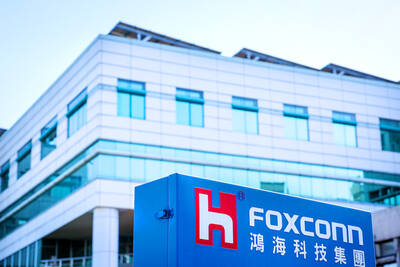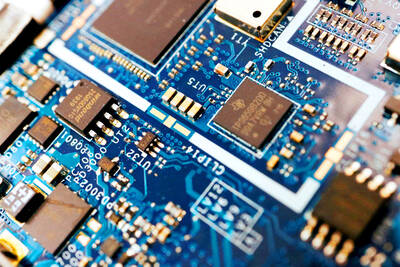Engineers and researchers have for many years dreamed of a world in which people could share immense computing power and data storage to improve the way they work.
Sun Microsystems Inc and National Central University (NCU) yesterday moved to realize that dream by establishing Taiwan's first grid-computing laboratory.
Grid, or distributed, computing emerged about five years ago and links hundreds or even thousands of computers to enable the sharing, selection and aggregation of a wide variety of geographically distributed computational resources. The technology aims to provide vast computing power or data storage to companies who pay only for what they use.
"So far, grid computing is mostly applied to the research domain -- such as civil engineering, the environment and such things -- but I'm sure it will be used in commercial computing in the next few years," Dinesh Bahal, director of Sun's global education and research in the Asia-Pacific region, said at a signing ceremony yesterday. "In short, it will change our way of working and doing business."
For the first three years of the cooperation, Sun and NCU will pump in NT$100 million in the Grid Computing Center.
The center will initially be used in NCU research projects for space remote sensing, optics, environment, communication systems and nanotechnology, said Chiang Wei-ling (
NTC also plans to invite institutions including National Tsing Hua University and National Chiao Tung University to participate in research, Chiang said.
"I think the cooperation will make us one of the world's top 500 universities in the high-performance computing field," he said.
Sun has already joined several other institutes, including the University of California, San Diego, in the US, the University of Ulm in Germany and the High Performance Computing Virtual Laboratory in Canada -- to develop grid computing technology.
"Grid computing is the most influential information technology in this century," said Alan Chang (張鴻瑜), general manager of Sun Microsystems Taiwan. "Currently, the utility rate of workstations, storage facilities and servers on the Internet is 5 percent to 20 percent on average, and with grid computing, it will drive up the rate to 98 percent, which will help to resolve a lot of complicated computing in a short time."
A pioneer in the field is SETI@home, a never-ending search for signs of life from space that began in the 1990s. The program uses idle computers to process data picked up by radiotelescopes.
Another example is the IBM/Oxford eDiamond project in Britain, which is a part of the government's "e-science initiative," helping doctors detect and treat breast cancer with five hospitals or screening centers sharing a grid.
In 2002 in Taiwan, IBM Corp, Academia Sinica and National Yang-Ming University built a biotechnology research center powered by grid computing provided by IBM. The grid connected seven biological institutions with a goal to expand the grid to more than 100 within three years.
IBM signed a similar research pact with National Cheng Kung University last year.

Hon Hai Precision Industry Co (鴻海精密) yesterday said that its research institute has launched its first advanced artificial intelligence (AI) large language model (LLM) using traditional Chinese, with technology assistance from Nvidia Corp. Hon Hai, also known as Foxconn Technology Group (富士康科技集團), said the LLM, FoxBrain, is expected to improve its data analysis capabilities for smart manufacturing, and electric vehicle and smart city development. An LLM is a type of AI trained on vast amounts of text data and uses deep learning techniques, particularly neural networks, to process and generate language. They are essential for building and improving AI-powered servers. Nvidia provided assistance

GREAT SUCCESS: Republican Senator Todd Young expressed surprise at Trump’s comments and said he expects the administration to keep the program running US lawmakers who helped secure billions of dollars in subsidies for domestic semiconductor manufacturing rejected US President Donald Trump’s call to revoke the 2022 CHIPS and Science Act, signaling that any repeal effort in the US Congress would fall short. US Senate Minority Leader Chuck Schumer, who negotiated the law, on Wednesday said that Trump’s demand would fail, while a top Republican proponent, US Senator Todd Young, expressed surprise at the president’s comments and said he expects the administration to keep the program running. The CHIPS Act is “essential for America leading the world in tech, leading the world in AI [artificial

DOMESTIC SUPPLY: The probe comes as Donald Trump has called for the repeal of the US$52.7 billion CHIPS and Science Act, which the US Congress passed in 2022 The Office of the US Trade Representative is to hold a hearing tomorrow into older Chinese-made “legacy” semiconductors that could heap more US tariffs on chips from China that power everyday goods from cars to washing machines to telecoms equipment. The probe, which began during former US president Joe Biden’s tenure in December last year, aims to protect US and other semiconductor producers from China’s massive state-driven buildup of domestic chip supply. A 50 percent US tariff on Chinese semiconductors began on Jan. 1. Legacy chips use older manufacturing processes introduced more than a decade ago and are often far simpler than

Gasoline and diesel prices this week are to decrease NT$0.5 and NT$1 per liter respectively as international crude prices continued to fall last week, CPC Corp, Taiwan (CPC, 台灣中油) and Formosa Petrochemical Corp (台塑石化) said yesterday. Effective today, gasoline prices at CPC and Formosa stations are to decrease to NT$29.2, NT$30.7 and NT$32.7 per liter for 92, 95 and 98-octane unleaded gasoline respectively, while premium diesel is to cost NT$27.9 per liter at CPC stations and NT$27.7 at Formosa pumps, the companies said in separate statements. Global crude oil prices dropped last week after the eight OPEC+ members said they would